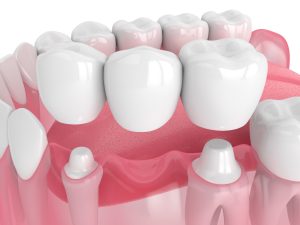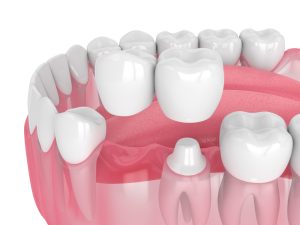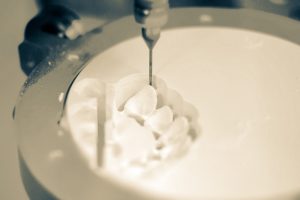What Are Fixed Dental Bridges?
Fixed dental bridges also simply called dental bridges, are prosthetic devices that fill the gap created by one or more missing teeth. They consist of an artificial tooth (or teeth) called a pontic, supported by dental crowns placed on the adjacent natural teeth or dental implants. Bridges restore your smile’s appearance, prevent the remaining teeth from shifting out of position, and maintain proper bite alignment.
Types of Fixed Dental Bridges
Traditional Dental Bridges
Traditional dental bridges consist of artificial teeth (pontics) held in place by dental crowns that are cemented onto the natural adjacent teeth on either side of the gap. The crowns serve as anchors for the dental bridge, providing stability and support.
Cantilever Dental Bridges
When adjacent teeth are present only on one side of the gap, a cantilever bridge is used. For this type of bridge, the artificial tooth is supported by a single dental crown placed over a third natural tooth or ‘abutment’ tooth adjacent to the space.
Maryland Dental Bridges
Also known as a resin-bonded bridge, a Maryland bridge uses a framework of metal or porcelain wings bonded to the back of adjacent natural teeth. The artificial tooth is then attached to these wings, offering a conservative option that requires minimal alteration of the adjacent teeth.
Implant-Supported Dental Bridges
Implant-supported bridges are anchored in place by dental implants surgically inserted into the jawbone. The implants act as sturdy foundations for the bridge, providing exceptional stability and durability for long-term tooth replacement.
Benefits of Dental Bridges
Some benefits of tooth bridges include:
- Restore Functionality: A dental bridge replaces missing teeth, enabling you to chew and speak properly, restoring the functionality of your mouth. With missing teeth replaced, you can enjoy your favorite foods without difficulty and communicate clearly.
- Preserve Facial Structure: Dental bridges help maintain the shape and structure of your face. This prevents the collapse of facial muscles and avoids a sunken appearance, contributing to a more youthful look.
- Prevent Teeth Shifting: Bridges prevent the remaining teeth from shifting out of their natural positions. This helps maintain proper alignment and bite function, reducing the risk of issues like bite misalignment or temporomandibular joint (TMJ) disorders.
- Even Distribution of Force: With missing teeth replaced, dental bridges ensure that the force of biting and chewing is evenly distributed across all teeth. This prevents excessive strain on individual teeth and reduces the likelihood of premature wear or damage.
- Enhance Aesthetics: Dental bridges improve the appearance of your smile by filling in gaps and restoring a uniform alignment of teeth. This enhancement can boost your confidence, improving self-esteem and a more positive self-image.
- Long-lasting Solution: A permanent bridge offers a durable and long-lasting solution for missing teeth. Properly cared-for bridges can endure for many years, providing functional and aesthetic benefits for an extended period.
Who Qualifies for Dental Bridges?
You may qualify for dental bridges if any of the following applies to you:
- Individuals with one or more missing teeth
- Patients with sufficient healthy teeth to support the bridge
- Those with adequate bone density to support dental implants (for implant-supported bridges)
- Individuals who practice good oral hygiene habits
- Patients committed to maintaining their dental bridges and overall oral health
The Dental Bridge Process
Consultation
Before getting a new dental bridge, you’ll have an initial consultation with Dr. Nishime. During your initial consultation, Dr. Nishime will examine your mouth, discuss your concerns, and determine if a dental bridge is the best solution for your missing teeth.
Treatment Planning
If a bridge is recommended, Dr. Nishime will create a personalized treatment plan tailored to your specific needs and goals. This includes deciding which type of dental bridge will best suit your smile.
Preparation
For a traditional dental bridge, the teeth supporting the bridge will be prepared by removing a small amount of enamel to accommodate the crowns. For an implant-supported bridge, small incisions will be made into your jaw bone through the gum tissue where the implants will be placed. For other non-traditional bridges, preparation of other teeth may be minimal or not be needed.
Design & Fabrication
Impressions and measurements of your teeth will be taken to design your custom dental bridge. A dental laboratory will fabricate your bridge using high-quality materials to ensure a natural-looking and comfortable fit. Depending on your case, you may receive a temporary dental bridge until your permanent dental bridge is ready.
Placement
Once the bridge is ready, Dr. Nishime will show you the restoration to make sure it’s to your liking. If you received a temporary bridge, this will be removed. Then, Dr. Nishime will carefully place the bridge, making sure it’s permanently cemented into place, and adjust it to achieve the perfect fit and bite alignment.
Dental Bridge Aftercare
Proper care is essential to maintaining your dental bridge. After dental bridge placement, follow these tips to get the most out of your bridge:
- Maintain excellent oral hygiene by brushing twice daily and flossing once a day.
- Visit your dentist in Honolulu regularly for dental check-ups and cleanings.
- Avoid biting or chewing on hard objects to prevent damage to your dental bridge.
- Rinse your mouth with an antiseptic mouthwash to keep the area around your bridge clean.
- If you experience any discomfort or notice any issues with your bridge, contact Advanced Restorative Dentistry immediately.
- Consider using a nightguard or splint if you grind your teeth at night to protect your dental bridge.
- Replace your dental bridge as recommended by Dr. Nishime, typically every five to 15 years, depending on the type and care.
Frequently Asked Questions
With proper care and maintenance, dental bridges can last 10 to 15 years or longer. If you opt for an implant-supported bridge, the implants can last a lifetime while the bridge will need to be replaced every 10 to 15 years due to normal wear and tear. The exact longevity of a fixed bridge depends on factors such as the type of bridge, oral hygiene habits, and bite force.
No, dental bridges are fixed prosthetic false teeth that are permanently attached to your natural teeth or dental implants. They cannot be removed like dentures, ensuring a comfortable, secure fit.
Yes, your dentist and dental technicians use high-quality materials and advanced techniques to ensure your dental bridge looks and feels natural.
Patients may experience some minor discomfort during the preparation and placement stages, but your dentist will ensure your comfort throughout the process using local anesthetic. Any discomfort can be managed with over-the-counter pain medication.
Discover the Life-Changing Power of Dental Bridges, Call Now!
If you’re ready to regain your confidence and enjoy a beautiful, functional smile, schedule your consultation for dental bridges with Dr. Nishime at Advanced Restorative Dentistry in Honolulu, HI, today. Our dedicated team provides exceptional care and personalized solutions for patients from Honolulu, Kailua, O’ahu, Kapolei, HI, and other surrounding areas.
Take the first step towards a transformed smile with a new dental bridge by calling (808) 732-0291 or visiting our website. Don’t let missing teeth hold you back any longer – embrace the life-changing power of dental bridges and let your smile shine!






